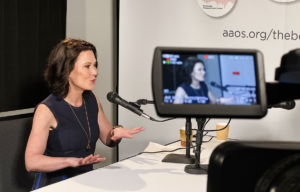A lot changed about how we do our jobs during the pandemic. For healthcare professionals, a watershed moment arrived for technology that was slowly trickling in for years.
All of a sudden, telehealth appointments became the norm and many felt unprepared for how to best connect with their patients in this new virtual setting. Even when the pandemic is over, telehealth is here to stay. The genie is out of the box. We now know it can be done. And isn’t it nice not having patients show up late because of traffic?
As an experienced media and public speaking trainer, during this pandemic I’ve found myself specializing in helping healthcare professionals present themselves from their computers — whether that be with patients in telehealth appointments or in media interviews and public speaking engagements for online conferences.
We’ve seen all the mistakes on TV. Cameras too low, cameras too high, dark rooms, terrible sound, distractions, and others I’m sure you’ve noticed.
This isn’t about looking good. It’s about making sure you connect with your audience. Making sure you do what you set out to accomplish with that telehealth appointment or media interview.
What are some ways you can improve your online presence and get better results?
Make it a great experience for the patient
This is what it’s all about. Your patients are coming to you with a health issue. They’re seeking comfort. They’re seeking guidance. And everything you do in a telehealth appointment should be supporting the goal of making the experience positive for them. Even though you’re connecting with your patients online, you want to make them feel cared for in the same way you would in person.
Experiencing a technical issue? Don’t panic! Consider jumping on a phone call instead and cut out all of the video distractions. Good sound and connecting with the patient are what’s most important here. Also don’t spend a ton of time complaining about or apologizing for any technical issues, that only takes time away from the patient’s time and it can start eroding their confidence in you. Address it once and then move forward with the appointment. Recently, I had a telehealth appointment where the head of the department kept apologizing for the tech issues and disparaging technology in general. It made the experience frustrating for me and he came across as out of touch, so it was harder to trust him. Telehealth is here to stay – learn it, love it, and definitely don’t complain about it!
Be aware of your lighting
When you’re interacting with a patient in person, they’re able to easily read your body language and facial cues. They can clearly see your eyes and connect with you. This helps you establish trust. When you’re meeting with a patient virtually, it’s important to make sure they can see you so that they can read these same cues over video. If your face is in a shadow or your patient can’t quite see your eyes, it’s going to be very difficult for them to feel connected to you and to trust you. Lighting is crucial to how you appear on the screen. You want to make sure there aren’t any windows behind you. Your light needs to come from in front of you. If you can, use natural light from a window. But if that isn’t an option, try soft lighting from a lamp you place in front of you – and be sure to avoid creating any shadows with your monitor or phone. These lights from Amazon are a really affordable option… under $100 and I’ve used them for years. If you wear glasses, try to avoid those commonly used ring lights. You’ll see the halos in your lenses and that’s distracting.
Invest in a quality camera
In the same way that good lighting is an essential part of how you appear on the screen, the quality of your camera will impact how well your patients can see you. Cameras built into computers aren’t the best quality, so you’ll want to invest in one that makes you look as close to how you do in real life as possible. This Logitech 1080p camera is about $80 and I recommend it to all my clients.
Once you have a camera, where you place it is key! You want to set it up at eye level so you are looking right into the camera – and right into the eyes of your patient. It may feel a little weird at first, looking at a camera instead of your patient on the screen, so make sure you practice looking directly into the camera and talking to it. Beware of putting the camera too low or too high – we don’t want to look up your nose or have a meeting with your neck or chin (or your boobs)!
Don’t forget about sound
Do not forget about sound. Clear communication is such an integral part of building trust with your patients, which is why you want to make sure you’re using a quality microphone so they can hear you. The sound of your voice can deliver a message that you care. We need to hear all the depth and range. During the pandemic, I had a family member who was very ill and I attended many telehealth appointments with them. There was one healthcare professional who was having sound issues during the entire appointment – her microphone was buzzing, she was cutting in and out and we kept mentioning it, but she couldn’t understand us. It was so frustrating because my family member was so sick and on top of that we were having to deal with not being able to hear what the doctor was saying. After the second time this happened, we just started making the trip to the office. This definitely isn’t how you want your patients feeling, so make sure you invest in a good microphone. AirPods work great. The mic is good and they are less distracting than a headset.
Dress… not distract
Just like you would for an in-person appointment, you want to present yourself well to your patients during a telehealth appointment. When you’re on camera, there are a few considerations to keep in mind that are a bit different from in-person. For clothes, you want to avoid high contrast patterns that don’t translate well. Go for rich, solid colors instead. Should you wear your white coat? That depends on the resolution of your camera and the background. If your camera has a low resolution or your background is predominantly neutral, you’ll want to avoid wearing your white coat as it won’t show up well. This is another reason to invest in a better camera. As far as accessories go, avoid loud jewelry because remember that quality microphone you ordered? It’s definitely going to pick up the sound of your bracelets clinking together when you gesture with your hands. That will be very distracting for your patients.
Above all else, when you’re thinking about ways to improve your telehealth appointments ask yourself, “Will this improve my patients’ experience and my connection with them?” That’s the goal: to create an environment where your patients feel cared for and supported, even though you’re not sharing the same physical space.
Interested in doing some one-on-one work on your telehealth technique? Let’s connect!
My new healthcare media training online class is launching soon. To get on the waiting list, sign up here!
Kathryn Janicek is a three-time Emmy winning media and public speaking trainer. She consults Fortune 500, healthcare, small businesses, tech companies & others on how to grow their business, attract better employees, increase brand equity and help their people be more confident by delivering more impactful messages to audiences.





